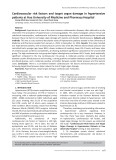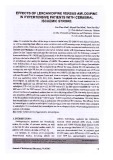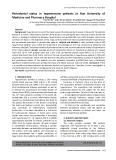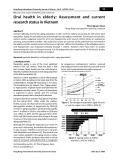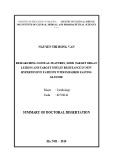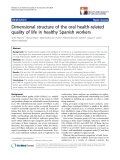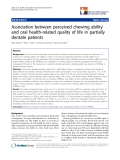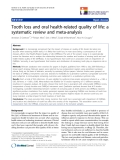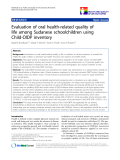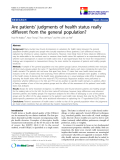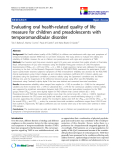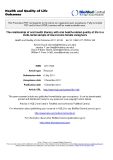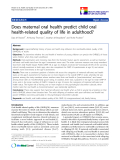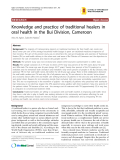
101
Journal of Medicine and Pharmacy, Volume 11, No.07/2021
Periodontal status in hypertensive patients at Hue University of
Medicine and Pharmacy Hospital
Tran Tan Tai1*, Doan Thi Van Khanh1, Ho Sy Minh Duc1, Nguyen Thi Thuy Hang2
(1) Faculty of Odonto-Stomatology, University of Medicine and Pharmacy, Hue University, Vietnam
(2)Department of Cardiology, Hue University of Medicine and Pharmacy Hospital, Vietnam
Abstract
Background: Hypertension is one of the major causes of cardiovascular diseases in the world. Periodontal
disease is a chronic inflammatory disorder of the tissues surrounding the teeth. Previous studies found that
there is a biological relationship between hypertension and periodontitis since both diseases share some
common risk factors. The objectives of this study were to determine the association between hypertension
and periodontal parameters in periodontitis patients. Subjects and Method: A cross-sectional study of 100
hypertensive patients who visited the Department of Cardiology at the Hue University of Medicine and
Pharmacy Hospital. Clinical examination of periodontal indices and interview about the history of hypertension
for all study subjects. Results: Average results of periodontal indices of hypertensive patients are: plaque
index (PlI) 1.83 ± 0.44, gingival index (GI) 1.20 ± 0.39, periodontal pocket depth (PPD) 2.72 ± 0.42 mm,
clinical attachment loss (CAL) 2.03 ± 1.50 mm; The rate of periodontitis in hypertensive patients is 74% with
proportion of moderate, severe and mild level are 34%, 26% and 13% respectively; duration of hypertension
and periodontal indices of the patients are also positively correlated (p<0.05).There was a statistically
significant relationship between periodontal status and blood pressure index (p <0.05). Conclusion: There
is a possible association between periodontal disease and hypertension. Therefore, further investigation is
recommended thus will help in managing oral and systemic health diseases.
Key words: hypertension, periodontal diseases, oral health.
Corresponding author: Tran Tan Tai; email: tttai@huemed-univ.edu.vn
Received: 15/11/2021; Accepted: 20/12/2021; Published: 30/12/2021
DOI: 10.34071/jmp.2021.7.13
1. INTRODUCTION
Hypertension, defined as values ≥ 140 mmHg
systolic blood pressure (SBP) and/or ≥ 90 mmHg
diastolic blood pressure (DBP), is the most common
of all cardiovascular diseases worldwide. as well as
in Vietnam [1]. According to the Global Burden of
Disease Study (2016), severe periodontal disease was
the 11th most prevalent condition in the world [2].
Periodontitis (PD) is a chronic inflammatory disease
caused by a dysfunctional microbiome that leads to
the gradual destruction of the tissues surrounding
the teeth and leading to tooth loss. Periodontitis
may contribute to inflammatory endothelial
dysfunction, it has been identified as a risk factor
for cardiovascular diseases. In recent years, many
studies have shown that periodontitis is associated
with hypertension [3 - 5]. Aguilera EM et al (2020)
systematically searched for articles published up to
2018, from 81 studies selected, 40 were included
in quantitative meta-analyses, showing a positive
association between periodontitis and hypertension.
The authors note that patients with moderate to
severe periodontitis had a higher prevalence of
hypertension than patients without periodontitis. In
addition, prospective studies confirmed PD diagnosis
increased likelihood of hypertension occurrence [6].
Currently, in Vietnam, there are few data on
the association between periodontal disease and
hypertension. The prevention and treatment of
periodontal disease for this subject has not been
paid enough attention. The aim of this study was to:
- To investigate periodontal status in hypertensive
patients through indicators: plaque index (PlI)
gingival index (GI), periodontal pocket depth (PPD)
and clinical attachment loss (CAL).
- To find out the relationship and correlation
between periodontal indices with the degree of
hypertension, duration of disease and some risk
factors in hypertensive patients.
2. SUBJECTS AND METHODS
2.1. Research subjects
The study sample included 100 patients
diagnosed with hypertension for at least 1 year,
diagnostic criteria according to the Vietnam
National Cardiology Association in 2018. Diagnosis
of hypertension when measuring blood pressure
in the clinic has a SBP ≥ 140 mmHg and/or a DBP









